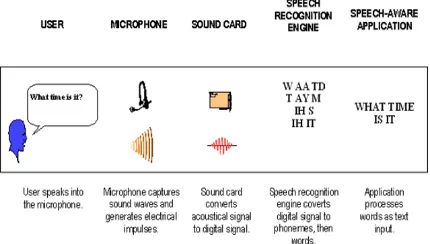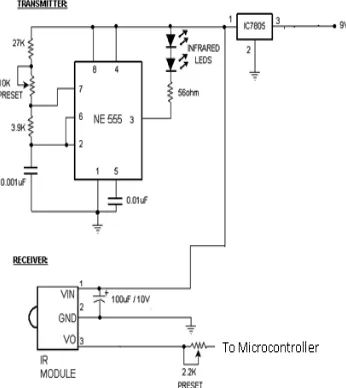A Voice Guidance Proposed System for
Autonomous Robot
Kajal Jewani
31TU
Kajal.jewani@ves.ac.inU31T
Neha Dingwani
31TU
nehadingwani3@gmail.comU31T
Pranali Sonawane
31TU
pranalis93@gmail.comU31T
Sanjivani Yesade
31TU
Sanjivani.yasade@gmail.comU31T
Vishal Motwani
31TUrvmotwani960@gmail.comU31T
ABSTRACT
In this paper, a voice guidance proposed system for autonomous robots is proposed, based on microcontroller. The proposed
proposed system consists of a
microcontroller and voice recognition software that can recognize a limited number of voice patterns. The commands of autonomous robots are classified and are organized such that voice recognition software can distinguish robot commands. Thus, the proposed proposed system can distinguish more voice commands than one voice recognition processor can.
I. INTRODUCTION
The proposed system describes a robot that can be operated by voice commands given from user. The system use speech recognition proposed system for giving and processing voice commands
Speech recognition, or speech-to-text, involves capturing and digitizing the sound
waves, converting them to basic language units or phonemes. It is the ability of a computer to recognize general, naturally flowing voice from a wide variety of users. The robot will receive commands from user and do the actions like left, right, back, front etc. The robot will detect the obstacles, fire and gas using sensor and do the work like if robot detect obstacle it moves in different direction, if robot detect fire it will stop the fire /buzzer the alarm and if it detect gas it will buzzer and produce sound.
The proposed system is to design and develop an intelligence robot to detect the dangerous gas, fire and obstacles by using an 8 bit microcontroller. The robot is designed to move as per the command given by the controller. If the Gas is detected then it will Switch on the BUZZER and the respective LED to alert the people.
Fig1. Block Diagram Of Transmitter
Fig2. Block Diagram of Receiver
When we say voice control, the first term to be considered is Speech Recognition i.e. making the proposed system to understand human voice. Speech recognition is a technology where the proposed system understands the words (not its meaning) given through speech. Speech is an ideal method for robotic control and communication. The speech recognition circuit we will outline, functions independently from the robot’s main intelligence [central processing unit (CPU)]. This is a good thing because it doesn’t take any of the robot’s main CPU processing power for word recognition. To control and command an appliance (computer, VCR, TV security proposed system, etc.) by speaking to it, will make it easier, while increasing the efficiency and effectiveness of working with that device. At its most basic level speech recognition allows the user to perform
parallel tasks, (i.e. hands and eyes are busy elsewhere) while continuing to work with the computer or appliance. Microphone will be used to get control on device which is to be switched on or off. The program on computer will take sound from mike as input and will compare it with English dictionary word which is set by us and will generate a command. The command generated by program will generate a 4 bit code on pc serial port. To serial is interface with the microcontroller circuitry which converts this serial code into parallel code give as input to Encoder. Encoder add to it 8 bit security code and final 12bit are converted into serial data and outputted on Dout pin of encoder(HT12E). These 12 bit are give as input to Ask (433/315 MHZ) transmitter. This module converts 12 bits into EM wave and radiate in air. Receiver on the mobile robot platform receives these 12 code and compare the 8 bit receives security code with the code set on the Decoder(HT12D). If these code match decoder separate 4 bit code converted from voice command. These 4bit code is given to microcontroller as input , were it is used to perform certain operation. Since 4bit code is received it can perform 16 different functions.
Sr. no Code Operation
1 0000 Stop
2 1111 Start
3 0001 Forward
4 0010 Reverse
5 0011 Left
6 0100 Right
Fig. Bit Pattern for Actions
II. PROPOSED VOICE
GUIDANCE PROPOSED
SYSTEM
A)
Interactive Voice ResponseProposed system (IVRS
)
Interactive Voice Response Proposed system (IVRS) is an application that integrates a Company’s/Organization's telephone and the computer proposed system to harmonize a CTI (Computer Telephony Interface) that transforms the caller’s telephone into a terminal capable of directly accessing information and services. Customer calls on a telephone number; the IVR Proposed system answers the call, and prompts for instructions via spoken voice menus. In response to the caller's requests, the database is fetched for suitable information and the result is presented to the caller in voice format. Applications of Interactive Voice Response Proposed system are Domestic gas booking agency, Order status inquiry, public and opinion polls, stock market price inquiry, voice mail proposed systems, ordering proposed systems for super market, etc
B) SAPI (Speech Application
Programming Interface)
The Speech Application Programming Interface or SAPI is an API developed by Microsoft to allow the use of speech recognition and speech synthesis within Windows applications. In general all versions of the API have been designed such
that a software developer can write an application to perform speech recognition and synthesis by using a standard set of interfaces, accessible from a variety of programming languages. Broadly the Speech API can be viewed as an interface or piece of middleware which sits between applications and speech engines (recognition and synthesis).
In addition to developing pioneering spoken language technology, Microsoft provides application programming interfaces (API’s) that allow Windows applications to use speech input and voice output. These are the same programming interfaces used by Microsoft desktop and server applications such as Windows® Speech Recognition, Microsoft® Narrator, Microsoft® Speech Server, and the spoken driving instructions included in Microsoft® Streets and Trips and Microsoft® MapPoint. The API provides a method of communication and coordination between the application and one or more speech engines. Microsoft makes available or includes a high-quality speech recognition engine and text-to-speech (TTS) engine for all recent Windows versions.
Fig. Speech Recognition Proposed system
C) Components of SAPI
1. Voice Command - high-level objects for command & control speech recognition
2. Voice Dictation - high-level objects for continuous dictation speech recognition
3. Voice Talk - high-level objects for speech synthesis
4. Voice Telephony - objects for writing telephone speech applications
III.
HARDWARE DESCRIPTIONA) SENSORS
Infrared beam barrier and a proximity
detector circuit with IC 555 infrared
detector circuit
Fig. Obstacle Sensor
The circuit uses the very popular Sharp IR
module. NOS pin circuit is shown in the
Sharp and Panasonic modules. For other
modules please refer to the relevant
datasheets. The receiver consists of a 555
timer IC working as an oscillator at about
38Khz (also works from 36kHz to 40kHz),
which must be configured using the standard
10K. The duty cycle of the IR beam is about
10%. This allows us to more current through
the LED, allowing a greater range. The
receiver uses a sharp IR unit. If the IR beam
from the transmitter IR drops, the output is
activated, this signal is fed to
microcontroller which activates the relay
and turns off when the beam is blocked.
B) Relay Driver
ULN2803
The eight NPN Darlington connected
transistors in this family of arrays are ideally
suited for interfacing between low logic
level digital circuitry (such as TTL, CMOS
or PMOS/NMOS) and the higher
current/voltage requirements of lamps,
relays, printer hammers or other similar
loads for a broad range of computer,
industrial, and consumer applications. All
devices feature open–collector outputs and
freewheeling clamp diodes for transient
suppression. The ULN2803 is designed to
be compatible with standard TTL families
while the ULN2804 is optimized for 6 to 15
volt high level CMOS or PMOS.
Fig3. Motor Relay Driver
The ULN2801A-ULN2805A each contains
eight Darlington transistors with common
emitters and integral suppression diodes for
inductive loads. Each Darlington features a
peak load current rating of 600mA (500mA
continuous) and can withstand at least 50V
in the off state. Outputs maybe paralleled for
higher current capability. Five versions are
available to simplify interfacing to standard
logic families: the ULN2801A is designed
for general purpose applications with a
current limit resistor; the ULN2802A has a
10.5k input resistor and zener diode for
14-25V PMOS (P-Channel MOSFET(metal-
oxide semiconductor field effect transistor));
the ULN2803A has a 2.7k input resistor for
5V TTL and CMOS, the ULN2804A has a
10.5k input resistor for 6-15V CMOS and
the ULN2805A is designed to sink a
minimum of 350mA for standard and
Schottky TTL where higher output current is
required. All types are supplied in an
18-lead plastic DIP with a copper 18-lead from and
feature the convenient input opposite-output
pin out to simplify board layout.
IV. BENEFITS OF THE
DESIGNED PROPOSED
SYSTEM
• Consistency of performance.
• 24/7 continuous working.
• Reduced amount of operator errors.
• Improved quality of product.
• It can move from one location to another location.
• It is also a Mobile Robot which has got certain artificial intelligence features.
• Robotic workers never get tired.
• Do not need to be paid.
• Can be made to perform even the most dangerous tasks without concern.
o Wide acceptance
V. CONCLUSION
A voice Guidance Proposed system for Autonomous Robot is proposed based on microcontroller and visual studio 2008. As the proposed proposed system consists of IVRs for speech recognition and other low cost components such as RF Transmitters, Receivers, sensors, relay driver etc. so it is cost effective. The Robot is designed to move by command through PC and by its own according to command given by the program. It is easy to detect any faults or dangerous places in industries and leads to the easy process without interaction of human. This proposed system is very much useful in the places where a human cannot go into the places like ground canals, smoke oriented caves and this proposed system is useful in such situations.
VI. REFERENCES
[1] MOHAMED FEZARI, “A Voice Command Proposed system for Autonomous Robots Guidance”, 0-7803-9511-5/06/$20.00 ©2006 IEEE
[2] C. E. Strangio, “Microcontroller instruction in the engineering laboratory”, IEEE Transactions on Education, Aug. 1988, vol. 31, no. 3, pp. 172-176. [3] http://www.xtendtech.com/devtools
[4] http://msdn.microsoft.com/en-us/library/ee721044.aspx [5] https://www.8051.com

